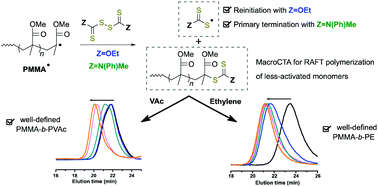Synthesis of PMMA-based block copolymers by consecutive irreversible and reversible addition–fragmentation chain transfer polymerizations†
Abstract
Easy to implement reversible-deactivation radical polymerization (RDRP) methodologies for the synthesis of block copolymers from monomers of disparate reactivities are scarce. We report the direct synthesis of PMMA-PVAc block copolymers by addition–fragmentation chain transfer polymerization without resorting to a chemical switch strategy. Instead, we took advantage of the good chain transfer activity of xanthogen and thiuram disulfides in methyl methacrylate (MMA) polymerization in order to obtain xanthate and dithiocarbamate-terminated PMMA (respectively PMMA-X and PMMA-T) displaying terminal functionalities of 0.9. Unlike PMMA-T, the xanthate group of PMMA-X was unstable and tended to partly degrade during the polymer purification. Both types of precursors have been successfully used as macro-chain transfer agents for RAFT polymerization of vinyl acetate (VAc). This simple method for block copolymer synthesis can be potentially applied to numerous combinations of more-activated and less-activated monomers. As an example, PMMA-T was chain extended with ethylene to achieve, for the first time using a RDRP, block copolymers incorporating PMMA and polyethylene (PE) segments.



 Please wait while we load your content...
Please wait while we load your content...